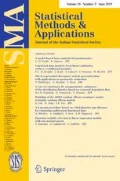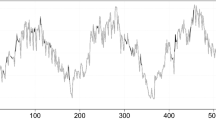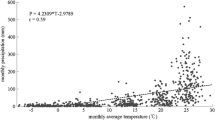Abstract
This paper examines the complex dependence between peak district heating demand and outdoor temperature. Our aim is to provide the probability law of heat demand given extreme weather conditions, and derive useful implications for the management and production of thermal energy. We propose a copula-based approach and consider the case of the city of Bozen-Bolzano. The analysed data concern daily maxima heat demand observed from January 2014 to November 2017 and the corresponding outdoor temperature. We model the univariate marginal behaviour of the time series of heat demand and temperature with autoregressive integrated moving average models. Next, we investigate the dependence between the residuals’ time series through several copula models. The selected copula exhibits heavy-tailed and symmetric dependence. When taking into account the conditional behaviour of heat demand given extreme climatic events, the latter strongly affects the former, and we find a high probability of thermal energy demand reaching its peak.









Similar content being viewed by others
Change history
03 September 2019
The original version of this article unfortunately contained a mistake.
References
Aloui R, Ben Aissa M, Hammoudeh S, Nguyen D (2014) Dependence and extreme dependence of crude oil and natural gas prices with applications to risk management. Energy Econ 42C:332–342
Ambach D, Croonenbroeck C (2016) Space-time short-to medium-term wind speed forecasting. Stat Methods Appl 25(1):5–20
Amjady N (2001) Short-term hourly load forecasting using time-series modeling with peak load estimation capability. IEEE Trans Power Syst 16(4):498–505
Balic D, Gudmundsson O, Wilk V, Sokolov D, Iakimetc EE, Grundahl L, Duquette J, Razani AR, Hansen AB, Nastasi B, Vigants G, Kotenko M, Mohammadi S, Qvist K, Larsen DS, Hasberg K, Fritz S, Casetta D, Thellufsen JZ, Zhang L, Pan OMd, Hansen K, Gilski P, Bevilacqua C (2015) Smart energy systems and 4th generation district heating. Int J Sustain Energy Plan Manag 10:25–27
Ben Ghorbal N, Genest C, Nešlehová J (2009) On the Ghoudi, Khoudraji, and Rivest test for extreme-value dependence. Can J Stat 37(4):534–552
Box G, Cox D (1964) An analysis of transformations. J R Stat Soc B 26:211–243
Box G, Jenkins G (1970) Time series analysis: forecasting and control. Holden-Day, San Francisco
Brechmann E, Schepsmeier U (2013) Modeling dependence with C- and D-vine copulas: the R package CDVine. J Stat Softw 52(3):543–552
Brunner MI, Sikorska AE, Seibert J (2018) Bivariate analysis of floods in climate impact assessments. Sci Total Environ 616–617:1392–1403
Catalina T, Iordache V, Caracaleanu B (2013) Multiple regression model for fast prediction of the heating energy demand. Energy Build 57:302–312
Charpentier A, Fermanian JD, Scaillet O (2007) The estimation of copulas: theory and practice. In: Jörn Rank (Ed) Copulas: from theory to application in finance. Risk Books, London, pp 35–64
Cherubini U, Luciano E, Vecchiato W (2004) Copula methods in finance. Wiley, Chichester
Connolly D, Mathiesen BV, Østergaard PA, Möller B, Nielsen S, Lund H, Trier D, Persson U, Nilsson D, Werner S (2012) Heat roadmap Europe 1: first pre-study for the EU27. Technical report
Connolly D, Mathiesen BV, Østergaard PA, Nielsen S, Persson U, Werner S (2013) Heat roadmap Europe 2050: second pre-study for the EU27. Energy engineering
Dahl M, Brun A, Andresen GB (2017) Using ensemble weather predictions in district heating operation and load forecasting. Appl Energy 193:455–465
Dotzauer E (2002) Simple model for prediction of loads in district-heating systems. Appl Energy 73(3–4):277–284
Duquette J, Rowe A, Wild P (2016) Thermal performance of a steady state physical pipe model for simulating district heating grids with variable flow. Appl Energy 178:383–393
Durante F, Sempi C (2015) Principles of copula theory. CRC Press, Boca Raton
Durante F, Fernández-Sánchez J, Pappadà R (2015) Copulas, diagonals, and tail dependence. Fuzzy Sets Syst 264(C):22–41
Durante F, Pappada R, Torelli N (2015b) Clustering of time series via non-parametric tail dependence estimation. Stat Pap 56(3):701–721
Ferraty F, Goia A, Salinelli E, Vieu P (2014) Peak-load forecasting using a functional semi-parametric approach. Top Nonparametr Stat 74:105–114
Genest C, Ghoudi K, Rivest LP (1995) A semiparametric estimation procedure of dependence parameters in multivariate families of distributions. Biometrika 82:543–552
Genest C, Rémillard B, Beaudoin D (2009) Goodness-of-fit tests for copulas: a review and a power study. Insur Math Econ 44:199–213
Goia A, May C, Fusai G (2010) Functional clustering and linear regression for peak load forecasting. Int J Forecast 26(4):700–711
Grønneberg S, Hjort NL (2014) The copula information criteria. Scand J Stat 41:436–459
Hofert M, Kojadinovic I, Maechler M, Yan J (2017) copula: multivariate dependence with copulas. R package version 0.999-18
Howard B, Parshall L, Thompson J, Hammer S, Dickinson J, Modi V (2012) Spatial distribution of urban building energy consumption by end use. Energy Build 45:141–151
Huang Z, Yu H, Peng Z, Zhao M (2015) Methods and tools for community energy planning: a review. Renew Sustain Energy Rev 42:1335–1348
Hutchinson TP, Lai CD (1990) Continuous bivariate distributions, emphasising applications. Rumsby Scientific Publishing, Sydney
Jacobsen H (2000) Technology diffusion in energy-economy models: the case of danish vintage models. Energy J 21(1):43–71
Joe H (2011) Dependence modeling: vine copula handbook. In: Tail dependence in vine copulae. World scientific, Singapore, pp 165–187
Kato K, Sakawa M, Ishimaru K, Ushiro S, Shibano T (2008) Heat load prediction through recurrent neural network in district heating and cooling systems. In: IEEE international conference on systems, man and cybernetics, 2008. SMC 2008. IEEE, pp 1401–1406
Kazas G, Fabrizio E, Perino M (2017) Energy demand profile generation with detailed time resolution at an urban district scale: a reference building approach and case study. Appl Energy 193:243–262
Kim JM, Jung H (2018) Dependence structure between oil prices, exchange rates, and interest rates. Energy J 39(2):233–258
Kojadinovic I, Yan J (2010) Modeling multivariate distributions with continuous margins using the copula R package. J Stat Softw 34(9):1–20
Kojadinovic I, Segers J, Yan J (2011) Large-sample tests of extreme-value dependence for multivariate copulas. Can J Stat 39(4):703–720
Kwiatkowski D, Phillips P, Schmidt P, Shin Y (1992) Testing the null hypothesis of stationarity against the alternative of a unit root. J Econom 54:159–178
Lund H, Mathiesen BV (2009) Energy system analysis of 100% renewable energy systems—the case of Denmark in years 2030 and 2050. Energy 34(5):524–531
Lund H, Möller B, Mathiesen BV, Dyrelund A (2010) The role of district heating in future renewable energy systems. Energy 35(3):1381–1390
Lund H, Werner S, Wiltshire R, Svendsen S, Thorsen JE, Hvelplund F, Mathiesen BV (2014) 4th Generation District Heating (4GDH). Integrating smart thermal grids into future sustainable energy systems. Energy 68:1–11
Ma W, Fang S, Liu G, Zhou R (2017) Modeling of district load forecasting for distributed energy system. Appl Energy 204:181–205
Mathiesen BV, Connolly D, Lund H, Nielsen MP, Schaltz E, Wenzel H, Bentsen NS, Felby C, Kaspersen P, Ridjan I et al (2014) Ceesa 100% renewable energy transport scenarios towards 2050: technical background report part 2
Nelsen RB (2006) Introduction to copulas. Springer, New York
Patton A (2012) A review of copula models for economic time series. J Multivar Anal 110:4–18
Persson U (2015) Current and future prospects for heat recovery from waste in European district heating systems: a literature and data review. Energy 110:25–26
Pircalabu A, Hvolby T, Jung J, Høg E (2017) Joint price and volumetric risk in wind power trading: a copula approach. Energy Econ 62(C):139–154
Popescu D, Ungureanu F, Hernández-Guerrero A (2009) Simulation models for the analysis of space heat consumption of buildings. Energy 34(10):1447–1453
Prando D, Patuzzi F, Pernigotto G, Gasparella A, Baratieri M (2014) Biomass gasification systems for residential application: an integrated simulation approach. Appl Therm Eng 71:152–160
Protić M, Shamshirband S, Petković D, Abbasi A, Mat Kiah ML, Unar JA, Živković L, Raos M (2015) Forecasting of consumers heat load in district heating systems using the support vector machine with a discrete wavelet transform algorithm. Energy 87:343–351
Raza MQ, Khosravi A (2015) A review on artificial intelligence based load demand forecasting techniques for smart grid and buildings. Renew Sustain Energy Rev 50:1352–1372
Reinhart CF, Cerezo Davila C (2016) Urban building energy modeling—a review of a nascent field. Build Environ 97:196–202
Rémillard B, Scaillet O (2009) Testing for equality between two copulas. J Multivar Anal 100(3):377–386
Rezaie B, Rosen MA (2012) District heating and cooling: review of technology and potential enhancements. Appl Energy 93:2–10
Said S, Dickey D (1984) Testing for unit roots in autoregressive-moving average models of unknown order. Biometrika 71:599–607
Salazar Y, Ng W (2015) Nonparametric estimation of general multivariate tail dependence and applications to financial time series. Stat Methods Appl 24:121–158
Serinaldi F, Bárdossy A, Kilsby C (2015) Upper tail dependence in rainfall extremes: would we know it if we saw it? Stoch Environ Res Risk Assess 29(4):1211–1233
Sklar A (1959) Fonctions de répartition à \(n\) dimensions et leures marges. Publications de l’Institut de Statistique de L’Université de Paris 8:229–231
Smith M, Hargroves K, Stasinopoulos P, Stephens R, Desha C (2007) Energy transformed: sustainable energy solutions for climate change mitigation. The Natural Edge Project, CSIRO, and Griffith University, Australia. https://eprints.qut.edu.au/85180/
Suganthi L, Samuel AA (2012) Energy models for demand forecasting—a review. Renew Sustain Energy Rev 16:1223–1240
Swan LG, Ugursal VI (2009) Modeling of end-use energy consumption in the residential sector: a review of modeling techniques. Renew Sustain Energy Rev 13:1819–1835
Trivedi PK, Zimmer DM (2007) Copula modeling: an introduction for practitioners. Found Trends Econom 1(1):1–111
Verrilli F, Srinivasan S, Gambino G, Canelli M, Himanka M, Vecchio CD, Sasso M, Glielmo L (2016) Model predictive control-based optimal operations of district heating system with thermal energy storage and flexible loads. IEEE Trans Autom Sci Eng 14(2):547–557
Wang X, Smith K, Hyndman R (2006) Characteristic-based clustering for time series data. Data Min Knowl Discov 13(3):335–364
Wang H, Wang H, Zhou H, Zhu T (2018) Modeling and optimization for hydraulic performance design in multi-source district heating with fluctuating renewables. Energy Convers Manag 156:113–129
Wojdyga K (2008) An influence of weather conditions on heat demand in district heating systems. Energy Build 40(11):2009–2014
Wu L, Kaiser G, Solomon D, Winter R, Boulanger A, Anderson R (2012) Improving efficiency and reliability of building systems using machine learning and automated online evaluation. In: 2012 IEEE Long Island, systems, applications and technology conference (LISAT). IEEE, pp 1–6
Yan J (2007) Enjoy the joy of copulas: with a package copula. J Stat Softw 21(4):1–21
Zhang S, Okhrin O, Zhou Q, Song PK (2016) Goodness-of-fit test for specification of semiparametric copula dependence models. J Econ 193(1):215–233
Zimmer D, Trivedi P (2006) Using trivariate copulas to model sample selection and treatment effects: application to family health care demand. J Bus Econ Stat 24:63–76
Acknowledgements
The authors are grateful to two referees for the many useful suggestions that have helped improve this paper. The first author (corresponding author F. Marta L. Di Lascio) acknowledges the support of the Free University of Bozen-Bolzano, Faculty of Economics and Management, via the project “The use of Copula for the Analysis of Complex and Extreme Energy and Climate data (CACEEC)” (Grant Nos. WW200S). The second author (Andrea Menapace) acknowledges Alperia and the Bozen-Bolzano province for providing the analysed data. The third author (Maurizio Righetti) acknowledges the support of the Free University of Bozen-Bolzano via the interdisciplinary project “Methods for optimization and integration given energy prices and renewable resources forecasts (MOIEREF)” (Grant Nos. WW2096).
Author information
Authors and Affiliations
Corresponding author
Additional information
Publisher's Note
Springer Nature remains neutral with regard to jurisdictional claims in published maps and institutional affiliations.
The original version of this article was revised: The original version of this article unfortunately contained a mistake. Maurizio Righetti’s given name and family name had been presented in the wrong order. The correct order is given here.
Rights and permissions
About this article
Cite this article
Di Lascio, F.M.L., Menapace, A. & Righetti, M. Joint and conditional dependence modelling of peak district heating demand and outdoor temperature: a copula-based approach. Stat Methods Appl 29, 373–395 (2020). https://doi.org/10.1007/s10260-019-00488-4
Accepted:
Published:
Issue Date:
DOI: https://doi.org/10.1007/s10260-019-00488-4




